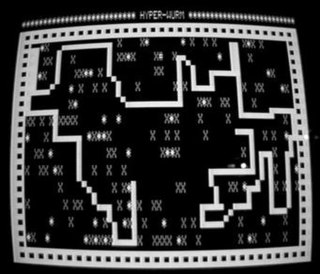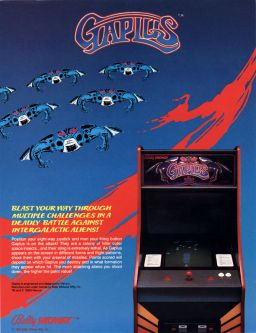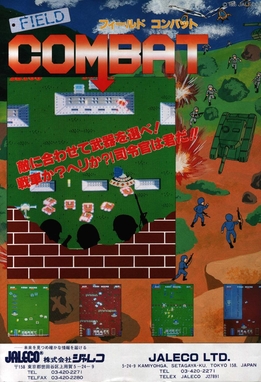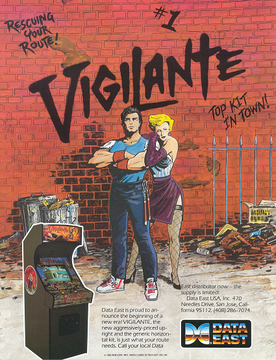
Snake is a sub-genre of action video games where the player maneuvers the end of a growing line, often themed as a snake. The player must keep the snake from colliding with both other obstacles and itself, which gets harder as the snake lengthens. It originated in the 1976 two-player arcade video game Blockade from Gremlin Industries where the goal is to survive longer than the other player. The concept evolved into a single-player variant where a snake gets longer with each piece of food eaten—often apples or eggs. The simplicity and low technical requirements of snake games have resulted in hundreds of versions—some of which have the word snake or worm in the title—for many platforms.

Frogger is a 1981 arcade action game developed by Konami and published by Sega. In North America, it was distributed by Sega/Gremlin. The object of the game is to direct five frogs to their homes by dodging traffic on a busy road, then crossing a river by jumping on floating logs and alligators.

A mobile game, or smartphone game, is a video game that is typically played on a mobile phone. The term also refers to all games that are played on any portable device, including from mobile phone, tablet, PDA to handheld game console, portable media player or graphing calculator, with and without network availability. The earliest known game on a mobile phone was a Tetris variant on the Hagenuk MT-2000 device from 1994.

Gaplus is a 1984 fixed shooter arcade game developed and released by Namco. It is the third game in the Galaxian series, serving as a direct sequel to Galaga (1981). In North America, a modification kit was later released to change the name to Galaga 3, possibly to reflect its position in the series. It was the only game other than Phozon to run on the Namco Phozon hardware. A contemporary home port for the Commodore 64 was released in 1988. A "demastered" version of the game was included in Namco Museum Archives Vol. 2 as a bonus title.

Ring King, known as King of Boxer in Japan and Europe, is an arcade boxing game developed by Woodplace. It was published in 1985 by Woodplace in Japan and Europe, and by Data East in North America.

Gun.Smoke is a vertically scrolling run and gun video game and designed by Yoshiki Okamoto and released in arcades in 1985. Gun.Smoke centers on a character named Billie Bob, a bounty hunter going after the criminals of the Wild West.

Field Combat is a 1985 shooter video game developed and published by Jaleco for arcades. In Field Combat, the player fights as a commanding officer in a futuristic battlefield. It was ported to the Famicom by Tose, which was later re-released for the Wii's Virtual Console in 2007. A sequel game, Field Combat DX, was released for Japanese mobile phones in 2004.

Blockade is a arcade video game developed by Lane Hauck for Gremlin and released in November 1976. It is a two-player game where each player controls the direction of an arrow on the screen which creates a trail behind it. The object is the avoid any walls surrounding the playfield or created by each player for a select amount of turns.

Vigilante (ビジランテ) is a 1988 beat 'em up arcade video game developed and published by Irem in Japan and Europe, and published in North America by Data East. It is considered as a spiritual sequel to Irem's earlier Kung-Fu Master (1984).

Chinese Hero, also known in Japan as Super Chinese, is a beat 'em up arcade video game developed by Nihon Game and published by Taiyo System and Taito in October 1984. Chinese Hero is the first game in the Super Chinese series. It was ported to the Nintendo Entertainment System as Kung-Fu Heroes in Japan by Nihon Game in 1986 and was published in North America in 1989 using the Culture Brain name. The game was included in a 2004 Game Boy Advance collection titled Super Chinese I+II Advance. It was released for the Nintendo Switch Online service on August 21, 2019.

Atari's Dominos is a one, two or four-player video action game packaged in its own distinctively styled upright cabinet that rest directly on the floor.

Driver's Eyes is a 1991 3D driving simulation arcade game developed and published in Japan by Namco. The game has a pseudo-panoramic view using three CRT screens; the player would sit in a then-realistic Formula One car cockpit with LCD instruments. The game would start with the player selecting either "easy drive" or "technical drive". Once the selection was made the screen would show a 3D model of a Formula One car with a V8 engine being placed into the engine bay and then the body work gliding down. As that happened the camera view would change and reveal a sign saying "BRAKES ON". When the sign lifted the race would start.

T.A.N.K. is a vertically scrolling multidirectional shooter developed and released in arcades by SNK 1985. It was published in North America as TNK III by Kitcorp. Versions of T.A.N.K. for home computers were released by Ocean Software for the ZX Spectrum, Commodore 64, and Amstrad CPC in 1987. A sequel was also released for the Nintendo Entertainment System titled Iron Tank.
Landing is a series of flight simulator video games by Taito. Almost all games were released for arcades, except the Jet de Go! Series released for PlayStation consoles.

Snake Rewind is a freemium mobile arcade video game developed and published by Rumilus Design and was released in May 2015 for iOS, Android and Windows Phone. Taneli Armanto, the developer behind the Snake game included by default in many Nokia phones that were produced 1997 and 1998, partnered with Rumilus Design to create this app. The game received positive and mixed reception from critics because of the glitchy control scheme.
Video gaming in Finland consists of video game industry of 260 active video game developer studios, roughly a dozen professional players and countless enthusiastic amateurs.

LeMans is a single-player race game created by Atari, Inc. in 1976. It was distributed in Japan by Namco. It is the successor to the Gran Trak 10 and Gran Track 20 video games.

Cosmo Gang the Puzzle is a 1992 falling block puzzle arcade video game developed and published by Namco worldwide. The third game in its Cosmo Gang series, succeeding that year's Cosmo Gang the Video, players stack groups of blocks and aliens known as Jammers in a vertical-oriented well. The objective is to clear as many objects on the screen before they reach the top of the screen. Blocks are cleared by aligning them into complete horizontal rows, while Jammers are cleared by defeating them with blue-colored spheres.

The popularisation of mobile games began as early as 1997 with the introduction of Snake preloaded on Nokia feature phones, demonstrating the practicality of games on these devices. Several mobile device manufacturers included preloaded games in the wake of Snake's success. In 1999, the introduction of the i-mode service in Japan allowed a wide variety of more advanced mobile games to be downloaded onto smartphones, though the service was largely limited to Japan. By the early 2000s, the technical specifications of Western handsets had also matured to the point where downloadable applications could be supported, but mainstream adoption continued to be hampered by market fragmentation between different devices, operating environments, and distributors.

Pitfall II: The Lost Caverns is a 1985 arcade game developed by Sega. It is based upon Activision's two home console games Pitfall! (1982) and Pitfall II: Lost Caverns (1984) for the Atari 2600. It has been described by historian Brett Weiss as a "rare occurrence" of an Arcade game being influenced by a console game.



















